
Video enhancement tech has come a long way, and artificial intelligence now sits at the heart of many upgrades filmmakers and brands rely on. Two names popping up everywhere in this space are DeepBrain AI and Pixop. While they both promise clearer, sharper videos, each takes a different path to get there.
In this side-by-side look, we break down features, pricing, and real-world uses so you can pick the right tool. Whether you run a YouTube channel, build campaigns for clients, or run a full production house, knowing what each platform does well-and what it does poorly-will steer you toward the best fit.
What is DeepBrain AI?
DeepBrain AI is a next-gen platform that uses artificial intelligence to spin up video content, and its signature virtual humans take centre stage. Instead of simply polishing existing footage, the service builds entirely new scenes around realistic avatars who can read scripts almost like real presenters.
Key Features of DeepBrain AI
AI Avatar Creation
DeepBrAIn AI shines when it comes to crafting lifelike avatars that can talk in dozens of languages. You can tweak their looks, clothes, and even the way they deliver each line, which makes them a solid choice for business webinars, online courses, and global marketing.
Text-to-Video Generation
With this tool, you type a script, and an AI presenter speaks it on screen. It speeds up making training clips, news updates, or marketing videos.
Multi-Language Support
The platform works in over 80 languages, so companies can quickly tailor videos for local audiences around the world.
Real-Time Video Generation
DeepBrain AI builds videos on the fly, opening doors for live streams and interactive video chats.
What is Pixop?
Pixop is a web-based service that cleans up and sharpens old video using clouds of machine learning. It mainly focuses on upscaling, fixing damage, and generally boosting streaming or archival material.
Key Features of Pixop
AI-Powered Upscaling
Pixops big strength is feeding lower-resolution clips and pushing them to crisp 4K or even 8K, all without losing detail.
Noise Reduction
The tool hunts down grain, static, and random digital junk, which is a lifesaver for aged tapes or footage shot in low light.
Deinterlacing
By swapping interlaced lines for a smooth progressive scan, Pixop ensures vintage TV exports look great on todays flat screens.
Frame Rate Conversion
Need a clip in 24 frames for film or 60 frames for a livestream? The service swaps speeds to meet any creative or broadcast need.
Batch Processing
Load up a folder and let Pixop run overnight. Processing lots of files at once saves huge amounts of time on big enhancement jobs.
DeepBrain AI vs. Pixop: Feature Comparison
Video Creation vs. Enhancement
DeepBrain AI and Pixop fill very different spots in the video world. DeepBrain AI uses avatars and smart automation to build brand-new videos, while Pixop takes existing clips and makes them shine.
Because it avoids traditional filming, DeepBrAIn AI suits businesses that need steady video output. Marketing teams can keep the same message fresh, and schools can quickly turn lessons into video training.
In contrast, Pixop helps anyone with a video archive that needs a quality boost. Film studios, broadcasters, and independent creators lean on its upgrade tools.
Technical Capabilities
Processing Speed
DeepBrAIn AI spits out new videos almost in real time, so its a go-to for deadline-driven projects. Pixops speed rests on the clips length and the kind of upgrades asked for-take longer yet usually deliver a finer finish.
Output Quality
Pictures DeepBrain AIs smooth, synthetic avatars and clean edits that look ready to post. Overall quality still rides on the avatar chosen and how detailed the script is.
Pixop aims to milk every pixel from old or low-res footage, often turning faded tapes into crisp streaming-ready content.
Customization Options
DeepBrain AIs control panel lets users tweak avatars, swap backdrops, and format scripts, plus bake in logos and brand colors.
Pixop stacks filters, upscalers, and noise reducers on one dashboard, letting creators dial in exactly how they want each clip to improve.
Integration and Workflow
API Access
Both services come with easy-to-use APIs that let developers link them to other tools. DeepBrain AIs API fits smoothly into content management systems and marketing automation suites, while Pixops API plays nicely with media asset-management software.
File Format Support
DeepBrain AI hands back videos in the popular MP4 and MOV formats. Pixop goes even further, accepting and exporting professional codecs that high-end productions often demand.
Cloud Processing
Since both run on powerful cloud servers, users never have to worry about pricey local machines. That means even solo creators or smaller shops can tap into top-tier video-processing tech without a huge upfront cost.
Pricing and Plans
DeepBrain AI Pricing
DeepBrain Ais plans usually come as monthly subscriptions, with levels that grant a set number of video minutes and access to different avatars. Custom avatars and extra tools arrive in the enterprise package, priced to fit larger teams.
New users can grab a free trial to see how the avatars perform and how quickly video renders, making it easier to decide whether to pay.
Pixop Pricing
Pixop runs on a credit system, so users buy packages of credits that pay for each video task. The cost dips based on a clips length, resolution, and how many enhancements are added.
For studios with big jobs or enterprise clients, volume discounts kick in, keeping large-scale video upgrades budget-friendly.
Use Cases and Applications
DeepBrain AI Use Cases
Corporate Communications
Companies turn to DeepBrain AI to make internal briefings, training videos, and executive messages. Because the same digital person appears every time, brand look and feel stay solid across all materials.
E-Learning and Education
Schools and universities build course slides, lectures, and how-to clips much faster. With support for many languages, educators can share lessons with learners around the world.
Marketing and Advertising
Marketers whip up promo videos, product demos, and eye-catching social posts, skipping the usual studio expenses.
News and Media
News outlets deploy AI anchors for breaking alerts and for set shows, keeping updates fresh without a live crew.
Pixop Use Cases
Film and Television
Studios upscale old scenes, sharpen low-res files, and ready footage for today-screens like 4K TVs and streaming hubs.
Content Libraries
Libraries packed with hours of video lean on Pixop to give their archives a modern polish.
Documentary Production
Documentary teams enhance retro clips and improve source quality, making every frame easier to watch and understand.
Broadcasting
TV networks upgrade their classic shows and movies for HD signals, ensuring audiences on cable and online get a crisp picture.
Pros and Cons of DeepBrain AI and Pixop
DeepBrain AI Advantages
- Creates videos in minutes.
- No cameras or on-location shoots.
- Every output looks uniform and polished.
- Speaks dozens of languages.
- Cuts costs when posting fresh content often.
DeepBrain AI Limitations
- Avatars can feel fake for some brands.
- Only produces presenter-style videos.
- Someone still must write a tight script.
- Imagination-heavy projects are better with camera work.
Pixop Advantages
- Makes footage sharper, clearer, and more vivid.
- Handles everything from clips to full-length films.
- Delivers cinema-quality upgrades.
- Processes many files at once.
- Keeps the original look and feel of each video.
Pixop Limitations
- Needs a clean master file to start.
- Larger jobs can take hours to finish.
- Results mirror the quality of the input.
- Fine tweaks, like timing or scripts, are harder.
- Rare glitches or artifacts still show up.
Making the Right Choice
Picking between DeepBrain AI and Pixop really boils down to what you hope to achieve and what files you already own.
Go with DeepBrain AI when you want fresh clips fast, lack a full production team, or need messages in several tongues. Its speed and budget-friendly model fit brands that post frequently and care about consistency.
Turn to Pixop when old videos need a facelift, you have archive material, or your library must meet today’s standards. The service is perfect for organizations wanting to preserve valuable footage while making sure it looks good on modern screens.
The Future of AI Video Technology
DeepBrain AI and Pixop are raising the bar in the world of video powered by artificial intelligence. While DeepBrain focuses on creating lifelike synthetic media, Pixop specializes in upgrading old footage so it looks brand-new.
As their tools improve, its common to see sharper images, quicker renders, and features that once felt like science fiction. Creation and enhancement pipelines may soon blend, letting users add original elements while polishing existing clips inside the same app.
Before picking a platform, think about what videos you make today, how much you can spend, and where you want your brand to be tomorrow. Free trials and demos from both companies let you experiment with your files and limits before committing real money.

